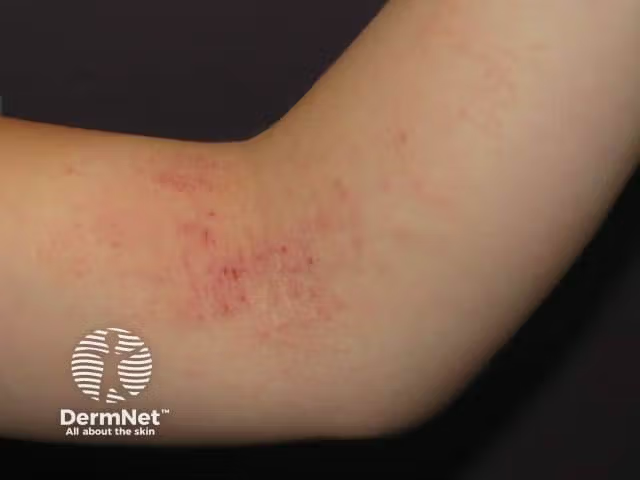- Case-Based Roundtable
- General Dermatology
- Eczema
- Chronic Hand Eczema
- Alopecia
- Aesthetics
- Vitiligo
- COVID-19
- Actinic Keratosis
- Precision Medicine and Biologics
- Rare Disease
- Wound Care
- Rosacea
- Psoriasis
- Psoriatic Arthritis
- Atopic Dermatitis
- Melasma
- NP and PA
- Skin Cancer
- Hidradenitis Suppurativa
- Drug Watch
- Pigmentary Disorders
- Acne
- Pediatric Dermatology
- Practice Management
- Prurigo Nodularis
- Buy-and-Bill
News
Article
Tailoring Atopic Dermatitis Treatment to Meet Patient Needs
Author(s):
Key Takeaways
- Systemic therapies, such as dupilumab, are recommended for severe AD, considering patient quality of life and treatment history.
- Non-systemic treatments, including tapinarof and barrier repair, are suitable for moderate AD, especially for hand dermatitis.
Adelaide A. Hebert, MD, FAAD, stressed the importance of educating patients, setting realistic expectations, and ensuring they adhere to AD treatment plans.

In a recent Dermatology Times Case-Based Roundtable event titled “Redefining Atopic Dermatitis Care: Tailoring Therapies to Patient Needs,” Adelaide A. Hebert, MD, FAAD, led a collaborative conversation for clinicians to explore complex cases regarding chronic atopic dermatitis (AD) management. Hebert, chief of pediatric dermatology at the University of Texas McGovern School of Medicine in Houston, stressed the importance of educating patients, setting realistic expectations, and ensuring they adhere to treatment plans.
Case 1: 27-Year-Old Woman with Severe Spongiotic AD
The first case focused on a 27-year-old female patient with severe spongiotic AD covering more than 20% of her body surface area. She experiences intense itching, sleep disturbance, and work-related difficulties as a schoolteacher, and she has had a history of moderate to severe AD since childhood. Previous treatments include emollients, topical corticosteroids, and oral steroids, in which long-term use has become a concern.
Hebert and the panelists discussed treatment strategies, emphasizing the importance of considering the patient’s quality of life, disease burden, treatment history, and personal preferences. They agreed that the patient warrants systemic therapy, such as dupilumab (Dupixent; Regeneron and Sanofi). Other options include other biologics such as tralokinumab (Adbry; LEO Pharma)and oral Janus kinase (JAK) inhibitors such as upadacitinib (Rinvoq; AbbVie) and abrocitinib (Cibinqo; Pfizer).
It’s important to address the patient’s concerns about long-term corticosteroid use by explaining potential adverse effects, such as weight gain, osteoporosis, and gastritis. Corticosteroids are for short-term “rescue” therapy, not chronic use. The clinicians also discussed the importance of educating patients on the availability of newer, safer treatment options for AD using handouts, photos, and other materials.
Conversely, the physicians addressed patient concerns about long-term biologic use, particularly the frequency of injections, such asdupilumab every 2 weeks. They discussed the possibility of extending the dosing interval to once monthly for some patients. Some reported success in stretching out dupilumab dosing in some patients, often by adding topical treatments such as tapinarof (Vtama; Organon). They cautioned against abruptly stopping medications, especially due to insurance changes, and advised patients to proactively address insurance issues to avoid treatment gaps.
In the end, the patient showed marked improvement after 16 weeks of dupilumab treatment combined with a topical emollient and triamcinolone. This led to a 70% reduction in her Eczema Area and Severity Index (EASI) score and improved sleep quality. She experienced mild conjunctivitis, which was managed with artificial tears and an ophthalmologist referral.
Case 2: Non Systemic Treatment for Moderate AD on the Hands
The next case followed a 36-year-old female patient with worsening moderate AD, affecting 8% of her body surface area, including her hands and arms. She experiences erythema, spongiosis, and severe itching, leading to sleep disturbances. She has a history of AD since childhood and a family history of the condition, as well as food allergies and hay fever. She has previously tried oral antihistamines, oral steroids, crisaborole (Eucrisa; Pfizer), and topical corticosteroids but is reluctant to continue topical steroids because of concerns about skin thinning. The patient is looking for a faster-acting treatment, preferably avoiding systemic options.
Hebert and the dermatologists emphasized the importance of barrier repair with moisturizers, particularly ceramide-containing products, and suggested protective measures, such as wearing gloves during dishwashing and avoiding hand sanitizers. Patch testing and allergy testing are also recommended to identify potential contact allergens.
Several doctors suggested tapinarof as a suitable option because of its once-daily, steroid-free application and efficacy for hand dermatitis. They also discussed the possibility of using dupilumab, roflumilast (Zoryve; Arcutis Biotherapeutics), light therapy, or methotrexate. Offering samples in the clinic is a great way to allow patients to trial new medications before committing to prescriptions. But even with initial improvement, maintenance therapy is vital, particularly for AD on the hands. The panelists recommended the continued use of crisaborole and emollients to further prevent flare-ups.
Open communication is another key factor in AD treatment. Presenting patients with a range of options from the start can prepare them for the possibility of switching medications due to inefficacy, intolerance, or insurance issues. The clinicians also communicated a comparison between the targeted approach of dupilumab and the broader immunosuppression of JAK inhibitors.
The case concluded with the patient showing significant improvement, reduced EASI score, improved sleep, and satisfaction with treatment without any application site reactions.
Case 3: Systemic Injections for Pediatric Patients
The final case revolved around a 7-year-old male patient with AD on 12% of his body surface area, causing frequent itching, discomfort, and exacerbations with the inability to sleep. The panelists quickly came to a consensus that the child was a good candidate for systemic dupilumab because of his age and disease severity.
The discussion highlighted recent findings regardingdupilumab’s positive impact on growth in children, as poorly controlled AD may lead to this impairment. Studies show a significant improvement in height percentile and muscle mass on dupilumab compared with those on placebo.
A potential concern with dupilumab is a child’s fear of injections. Hebert and the clinicians mentioned some of their favorite strategies for minimizing the discomfort associated with needles, such as using ice packs or emphasizing the short injection time of 5 to 6 seconds for the syringe. Other mentioned treatment options included a short course of cyclosporine with a topical regimen such as tapinarof or crisaborole. However, the positive outcomes make dupilumab the strongest recommendation for this patient.





